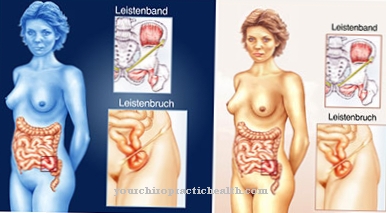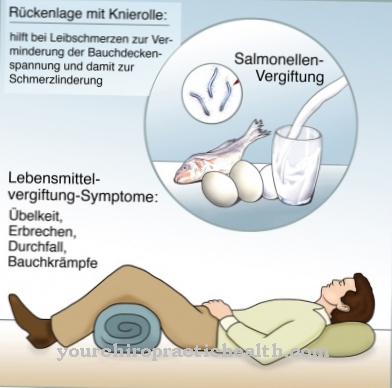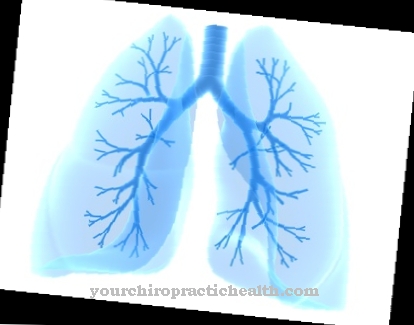A Varicocele or Varicose vein hernia is a varicose vein-like enlargement of the testicular vein and the venous plexus in the scrotum (testes), which is the most common cause of infertility in men. Varicoceles are treated surgically or with sclerotherapy (sclerotherapy), which in many cases can reverse an existing infertility.
What is a varicocele?
As Varicocele (varicose vein hernia) is a varicose vein-like expansion, extension and winding of the testicular vein (Vena testicularis) and the venous plexus in the testes and epididymis (so-called pampiniform plexus).
About 10 to 20 percent of men, especially between the ages of 15 and 25, can be affected by a varicocele that usually does not cause any symptoms. Only in a few cases does a varicocele manifest itself in the form of a pulling pain in the testicles and groin area, which occurs particularly during physical exertion.
Depending on its degree of expression, a varicocele affects fertility (fertility) via various mechanisms (including an increase in body temperature in the area of the testicles) and is the most common cause of sterility (infertility) in men many cases can be restored.
causes
In most cases there is one Varicocele can be attributed to a constitutional disturbance of the blood flow of the testicular vein into the left renal vein (primary varicoceles). This leads to an impairment of the functionality of the venous valve in the testicular vein, which in turn increases the pressure in this blood vessel.
The increase in pressure causes the varicose vein-like expansion of the testicular vein or the entire venous plexus in the testicle, which is characteristic of the varicocele. The disruption of the blood flow can be caused by a narrowing of the renal vein by the aorta (main artery) or the aortic branch or by an anatomically unfavorable transition of the testicular vein into the renal vein.
In addition, tumors can lead to an increase in pressure due to their expansion and vascular tears or blood clots cause a disruption of the blood flow. In the latter two cases, symptomatic varicoceles are used.
Symptoms, ailments & signs
A varicocele (varicose vein hernia) does not usually cause any symptoms. Often it is discovered only by chance during examinations. Sometimes, however, there are also complaints. In individual cases, the varicose vein hernia can even lead to infertility in the affected men. However, testicular varicose veins are relatively common.
Up to 20 percent of all young men are affected by a varicose vein hernia. Most of the time, the varicose veins develop in the left testicle. They can also be felt there manually. In rare cases, varicoceles show symptoms, which are then very characteristic. A heavy scrotum with a feeling of sore is typical. It can cause intense pain in the testicles, especially when standing. Worm-like swellings are often observed on the scrotum, which are often noticeable when there is increased abdominal pressure during pressing.
But these swellings can also occur without abdominal pressure. Sometimes the affected testicle is smaller because the varicose plexus prevents it from growing. The varicose veins create a backlog of blood near the testicle, so that there is a higher temperature.
Since testicular development and sperm production are very temperature-dependent, the varicocele can lead to reduced sperm production. In extreme cases all sperm production comes to a standstill, so that the patient becomes sterile. However, since only one testicle is usually affected, fertility is usually retained with a varicocele.
Diagnosis & course
Varicoceles are usually diagnosed as part of a physical examination in which the testicles are scanned in different positions (standing, lying, squatting). Statements about the stage are already possible here. First-degree varicoceles can be felt as worm-shaped clusters while standing while simultaneously performing the Valsalva maneuver (abdominal press).
In contrast, second-degree varicoceles can be palpated while standing without the Valsalva maneuver, while third-degree vein plexus expansions can be seen through the skin using the varicose veins. Subclinical varicoceles (initial stage), on the other hand, can only be detected in the context of Doppler sonography (ultrasound of vessels) using the Valsalva maneuver.
With the help of sonography, a kidney tumor can also be excluded and the testicular structure and size determined. A phlebography (x-ray with contrast agent) provides information about the functionality of the venous plexus. If left untreated, a varicocele leads to infertility.
Complications
A varicocell can cause a variety of complications. First of all, there is a risk that the varicose vein hernia will lead to impaired sperm formation. This can lead to infertility and the inability to conceive. Serious testicular dysfunction can also occur if the varicocell is not treated.
This is usually accompanied by severe pain, which can be a great burden for the person concerned. If the varicocell is based on a kidney tumor, this can cause further complications. If the treatment is not received, the result is kidney failure, metastasis and, in the further course, death of the patient.
During a surgical procedure, organs and structures in the area of the procedure can be injured, for example the vas deferens or the urethra. Bleeding, bruising, and nerve damage can occur. Injury to a testicle cannot be ruled out either. In some cases, a so-called hydrocele occurs, a build-up of water in the scrotum that can be associated with pain and dysfunction.
If the patient is allergic, there is a risk of an allergic reaction to the agents and materials used. Interactions with the prescribed medication can also occur and sometimes lead to serious health complications.
You can find your medication here
➔ Medicines for potency and erection problemsWhen should you go to the doctor?
Due to its characteristics, the varicose vein hernia can only occur in sexually mature boys and men. The person concerned often remains symptom-free for a long time, which is why a diagnosis is made during a routine examination. It is generally advisable to carry out regular health check-ups. This enables the early detection of existing diseases and can contribute to the timely application of appropriate treatment methods. Any abnormalities and peculiarities of the scrotum should be discussed with a doctor.
If there are discomforts during the sexual act or ejaculation, an investigation of the cause is required. If the desire to have children is unfulfilled, medical tests can be used to find out which disorder is causing this situation. Therefore, a doctor should be consulted if, despite all efforts, pregnancy still does not occur after a few months. If you feel uncomfortable when you apply pressure to the scrotum, you should discuss the observation with a doctor.
If the size of the testicles is very different, this can be interpreted as a warning signal. Consultation with a doctor is recommended so that it can be clarified whether there is a need for treatment. Pain in the genitals, irregular locomotion, or impairment in movement should also be examined. They lead to disturbances in everyday life and in severe cases can trigger complications that should be avoided.
Treatment & Therapy
The therapeutic measures depend on one Varicocele on the extent and stage of the disease. With increasing complaints and pathological spermiogram (analysis of the ejaculate), what is known as transcatheter sclerotherapy is nowadays preferably carried out to obliterate the varicocele.
With this treatment method, a differentiation is made between retrograde and antegrade varicoceles sclerotherapy. As part of a retrograde sclerotherapy, the inguinal vein is punctured, from where a catheter is pushed over the renal vein to the enlarged area of the venous plexus and the sclerosing agent is then injected through the catheter. In antegrade sclerotherapy, a catheter is placed directly in the dilated vein, through which the sclerosing agent is injected.
Antegrade sclerotherapy is usually performed under local anesthesia, as the person concerned should press during the procedure if possible. In addition to these non-surgical procedures, surgical methods are used to treat a varicocele. Either the entire vascular bundle (Palomo operation) or only the testicular vein (testicular vein) is tied off (Bernardi operation). In both cases, this is done either via an incision in the lower abdomen or laparoscopically (buttonhole surgery) with the help of several small incisions.
With the inguinal surgical method, the incision is made directly at the level of the groin and all veins of the spermatic cord are tied off. All of the mentioned treatment methods for a varicocele are rated as equally good in terms of therapeutic success.
prevention
There Varicoceles is due to a disturbed blood flow of the testicular vein (testicular vein), which is usually genetically or anatomically conditioned, this cannot be prevented directly.
Aftercare
If the varicocele is treated surgically and the procedure is carried out on an outpatient basis, the patient cannot drive a car or any other means of transport for 24 hours. Machines are also not allowed to be operated and important decisions are better to be made on another day.
Following the surgical procedure, it is advisable for the patient to allow himself to be given bed rest for at least one day. Even after this, physical rest of about 14 days is recommended. Sports activities must be avoided during this period.
For the follow-up treatment of the operation, the scrotum should be regularly cooled with ice for the first 24 hours. This procedure can prevent possible bleeding. The staples or sutures that are attached during the surgical procedure usually resolve on their own. Threads for which this is not possible will be removed by the doctor after about eight days. It is very important to attend the check-ups.
After treating the hernia of the varicose vein, it is advisable to put on elastic underpants to support the scrotum. Alternatively, it is also possible to carry a scrotum holder. Two days after the operation, the patient is allowed to shower again. After removing the threads or staples, he can take a bath again.
You can do that yourself
The varicocele needs medical attention. Weak varicose veins usually do not require treatment, but diagnosis and observation. Patients should pay close attention to any unusual symptoms and consult the urologist if necessary.
A larger varicocele must be surgically removed. After such an operation, rest and bed rest apply. In the first few days after the procedure, pain may occur, which can be relieved by gentle cooling. In consultation with the doctor, the use of natural remedies is also permitted. Cooling agents have also proven themselves, for example marigold ointment or a cool pad with green tea or black tea. At the same time, attention must still be paid to any unusual symptoms. Bleeding or pain reactions can occur, which must be clarified by a doctor.
Should infertility occur as a result of the varicocele, therapeutic advice is required. Men with a strong desire to have children or active family planning in particular need the support of a specialist to process the incision. It may also be useful to talk to other people affected. In addition to self-help groups, there are forums on the Internet. Specialized reading and the search for alternative options are also important self-help measures after a difficult varicocele.



.jpg)




















.jpg)



